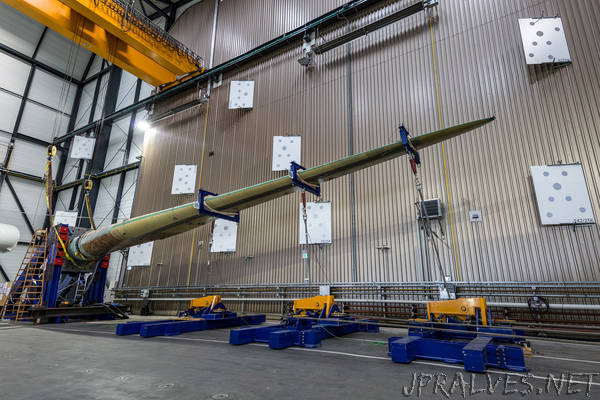
“The share of the overall electricity market made up by wind energy continues to grow year after year. The giant rotor blades are one central part of a turbine. In the “SmartBlades” project, the Fraunhofer Institute for Wind Energy Systems IWES and its partners developed a rotor blade, which, thanks to an innovative bend-twist coupling, is able to make more efficient use of large fluctuations in wind strength. In the follow-up project “SmartBlades2”, the concept will undergo experimental tests using a demonstrator.
More than 28,000 wind turbines with a total output of 50 gigawatts are currently in operation in Germany: This equates to a 12.3 percent share of the total electricity production in Germany in 2016. This figure places the German wind energy sector at the top of the European league table, as confirmed by the German Wind Energy Association’s data. The current focus of research is now on developing this technology even further. And the Fraunhofer Institute for Wind Energy Systems IWES, based in Bremerhaven, is leading the way here. Within the framework of the joint “SmartBlades2” project, researchers have turned their attention to the bend-twist coupling (BTC) concept for rotor blades. The passive working coupling adapts continuously to the wind forces acting on the rotor blade. When the wind loads become too high, the bend-twists reduces the forces affecting the structure.
The rotor blades of conventional wind turbines react to changing wind strengths very slowly. A rotor blade measuring up to 85 meters in length describes a circular area of 22,670 m², that’s the equivalent of four soccer pitches or St. Peter’s Square in Rome. The wind strengths within this area can vary greatly. The pressure acting upon the blade pointing upward, for example, can be very different from the pressure on the lower blade. Conventional rotor blades cannot compensate for a single gust of wind as they are too rigid to twist. This means if there is a gust when the wind is already strong, the turbine operators turn the rotor blades completely away from the wind. This results in long downtimes during which no electricity is produced.
“The demonstrator BTC blade developed as part of this project is swept back whilst the blade tip is offset slightly to the rear in the direction of rotation. The 20-meter-long rotor blade is therefore able to rotate slightly around its own axis should strong gusts occur in order to mitigate the wind pressure to a certain degree,” explained the IWES technology coordinator for BTC blades, Dr. Elia Daniele. This reduces the forces acting upon the blade and, ultimately, the entire turbine. By using BTC blades on a newly planned wind turbine, the overall turbine weight can be reduced as the structure is subjected to lower loads. In case of existing turbines, the retrofitting of BTC blades allows the rotor diameter to be increased without having to adapt the other turbine components. This results in an increase in revenue thanks to a greater wind yield.
Testing under realistic conditions
To test this innovative design, static and dynamic tests will be conducted on the Fraunhofer IWES’ rotor blade test bench in Bremerhaven over a period of several weeks. The test engineers have installed a BTC blade for the first time here. The blade was designed by Fraunhofer IWES and produced by the project partner German Aerospace Center (DLR). Its durability when subject to extreme loads will be tested in static tests. “Although the setup for the rotor blade torsion test is similar to the conventional scenario for static testing, it is in fact more complex, as the additional deformation has to be measured precisely,” said IWES test engineer Tobias Rissmann, summarizing the particular challenge of this test. Deformation along the three main axes was monitored using a visual measurement system. Angle sensors were also used to ensure that the force was indeed introduced vertically to the blade axis. During the subsequent dynamic tests (fatigue tests), the stresses incurred over the entire service life of the rotor blade spanning 20 years are simulated within a drastically reduced time frame.
Upon completion of the test bench testing, three identical BTC rotor blades will be transported to the USA. Upon arrival, they will be installed at the foot of the Rocky Mountains for a field test on a research turbine from the project partner National Renewable Energy Laboratory (NREL). The aim of subsequent measurements, which will be led by Fraunhofer researchers, is to demonstrate whether passive twisting performs as expected in real, open-air operation. The “Aeroprobe System” which has been newly developed as part of this project will also be used for testing: two pressure sensors on the surface of the blade measure the flow dynamics around the rotor blades. The flow on the rotor blade is also made visible by strands of wool. This allows the experts at Fraunhofer to determine the aerodynamic conditions precisely. Within the blade, further sensors work to measure the acceleration at the blade tips while camera reflector systems detect any deformation.
Fraunhofer IWES is not planning to design rotor blades itself, but rather is focused on developing its expertise in this field and making this available to its industrial partners. The BTC blade serves to demonstrate the technology and assess the usability of this technology on commercial blades.
The German Federal Ministry for Economics Affairs and Energy (BMWi) has provided funding for the “SmartBlades2” project to the tune of €15.4 million. On the industrial side, various blade and turbine manufacturers are involved in order to determine the potential for industrial applications.”
